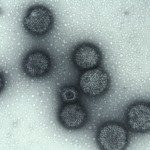Link to Pubmed [PMID] – 26447467
PLoS ONE 2015;10(10):e0139481
Chikungunya virus (CHIKV) is a reemerging, ordinarily mosquito-transmitted, alphavirus that occasionally produces hemorrhagic manifestations, such as nose bleed and bleeding gums, in human patients. Interferon response factor 3 and 7 deficient (IRF3/7-/-) mice, which are deficient for interferon α/β responses, reliably develop hemorrhagic manifestations after CHIKV infection. Here we show that infectious virus was present in the oral cavity of CHIKV infected IRF3/7-/- mice, likely due to hemorrhagic lesions in the olfactory epithelium that allow egress of infected blood into the nasal, and subsequently, oral cavities. In addition, IRF3/7-/- mice were more susceptible to infection with CHIKV via intranasal and oral routes, with IRF3/7-/- mice also able to transmit virus mouse-to-mouse without an arthropod vector. Cynomolgus macaques often show bleeding gums after CHIKV infection, and analysis of saliva from several infected monkeys also revealed the presence of viral RNA and infectious virus. Furthermore, saliva samples collected from several acute CHIKV patients with hemorrhagic manifestations were found to contain viral RNA and infectious virus. Oral fluids can therefore be infectious during acute CHIKV infections, likely due to hemorrhagic manifestations in the oral/nasal cavities.

